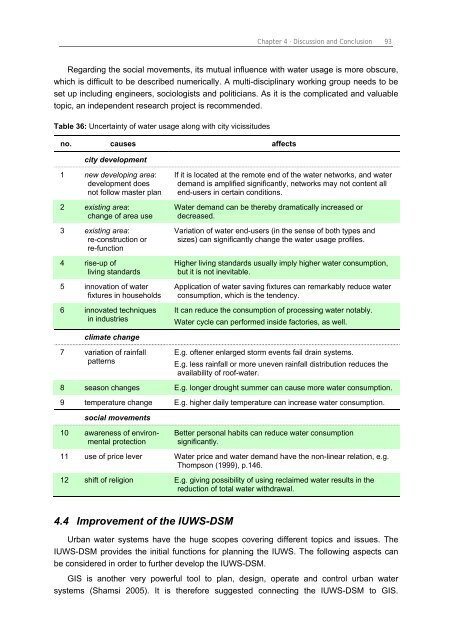Chapter 3 Decision Support Model (IUWS-DSM) - Tubdok
Chapter 3 Decision Support Model (IUWS-DSM) - Tubdok
Chapter 3 Decision Support Model (IUWS-DSM) - Tubdok
You also want an ePaper? Increase the reach of your titles
YUMPU automatically turns print PDFs into web optimized ePapers that Google loves.
<strong>Chapter</strong> 4 · Discussion and Conclusion 93<br />
Regarding the social movements, its mutual influence with water usage is more obscure,<br />
which is difficult to be described numerically. A multi-disciplinary working group needs to be<br />
set up including engineers, sociologists and politicians. As it is the complicated and valuable<br />
topic, an independent research project is recommended.<br />
Table 36: Uncertainty of water usage along with city vicissitudes<br />
no. causes affects<br />
city development<br />
1 new developing area:<br />
development does<br />
not follow master plan<br />
2 existing area:<br />
change of area use<br />
3 existing area:<br />
re-construction or<br />
re-function<br />
4 rise-up of<br />
living standards<br />
5 innovation of water<br />
fixtures in households<br />
6 innovated techniques<br />
in industries<br />
climate change<br />
7 variation of rainfall<br />
patterns<br />
If it is located at the remote end of the water networks, and water<br />
demand is amplified significantly, networks may not content all<br />
end-users in certain conditions.<br />
Water demand can be thereby dramatically increased or<br />
decreased.<br />
Variation of water end-users (in the sense of both types and<br />
sizes) can significantly change the water usage profiles.<br />
Higher living standards usually imply higher water consumption,<br />
but it is not inevitable.<br />
Application of water saving fixtures can remarkably reduce water<br />
consumption, which is the tendency.<br />
It can reduce the consumption of processing water notably.<br />
Water cycle can performed inside factories, as well.<br />
E.g. oftener enlarged storm events fail drain systems.<br />
E.g. less rainfall or more uneven rainfall distribution reduces the<br />
availability of roof-water.<br />
8 season changes E.g. longer drought summer can cause more water consumption.<br />
9 temperature change E.g. higher daily temperature can increase water consumption.<br />
social movements<br />
10 awareness of environmental<br />
protection<br />
Better personal habits can reduce water consumption<br />
significantly.<br />
11 use of price lever Water price and water demand have the non-linear relation, e.g.<br />
Thompson (1999), p.146.<br />
12 shift of religion E.g. giving possibility of using reclaimed water results in the<br />
reduction of total water withdrawal.<br />
4.4 Improvement of the <strong>IUWS</strong>-<strong>DSM</strong><br />
Urban water systems have the huge scopes covering different topics and issues. The<br />
<strong>IUWS</strong>-<strong>DSM</strong> provides the initial functions for planning the <strong>IUWS</strong>. The following aspects can<br />
be considered in order to further develop the <strong>IUWS</strong>-<strong>DSM</strong>.<br />
GIS is another very powerful tool to plan, design, operate and control urban water<br />
systems (Shamsi 2005). It is therefore suggested connecting the <strong>IUWS</strong>-<strong>DSM</strong> to GIS.

















